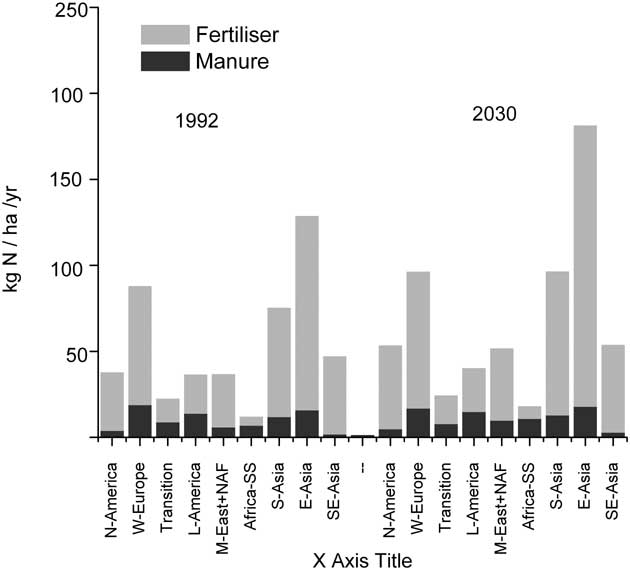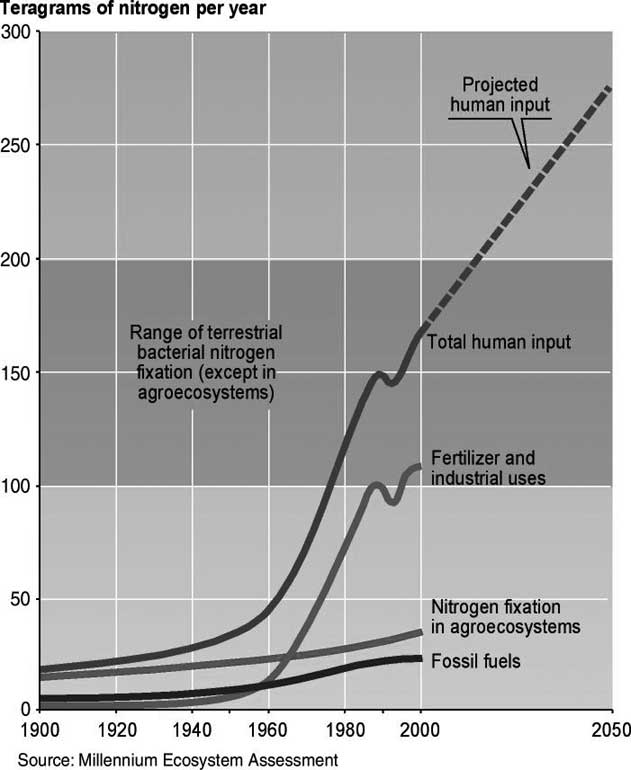
Figure 4-12. Nitrogen application (fertilizer and manure) in 1995 and 2030. Source: Bouwman et al., 2005.
quantity of manure is expected to increase, especially in Asia (Bouwman et al., 2005).
The increased use of fertilizer and manure will lead in many regions in the world to increased losses of reactive N and of phosphorous (P) to the environment, causing increasingly more severe environmental problems. Emissions do not only stem from agriculture; the combustion of (fossil) fuels and emissions from industries and households lead to increased levels of N and P in the environment (Figure 4-13). These emissions have already caused a range of environmental problems (MA, 2005a). The presence of excess nutrients (N, P) in water can lead to eutrophication (Bennett et al., 2001; Galloway et al., 2002) causing algal blooms, changes in resident organisms, low dissolved oxygen, and generally lower water quality. Nitrogen losses to groundwater can increase nitrate (NO3) concentrations to levels which can have serious effects on human health. Aerial deposition of reactive N into natural terrestrial ecosystems, especially temperate grasslands, shrublands, and forests, could lead to lower plant diversity. Nitrous oxide is a powerful greenhouse gas. In 2000, nitrous oxides stemming from agriculture were responsible for more than 6% of global greenhouse gas emissions (EPA, 2006).
Nutrient loading will become an increasingly severe problem, particularly in developing countries and in East and South Asia (MA, 2005a). On the basis of projections for food production and wastewater effluents, the global river N flux to coastal marine systems may increase by 10-20% in the next 30 years. While river N flux will not change in most wealthy countries, a 20-30% increase is projected for poorer countries, which is a continuation of the trend observed in the past decades. The export is expected to reach 50 million tonnes year-1 by the year 2030 with the Pacific Ocean experiencing the greatest increase (Bouwman et al., 2005; MA, 2005a).
Source: Millennium Ecosystem Assessment
 Figure 4-13. Global trends in the creation of reactive nitrogen by anthropogenic activities. Source: MA, 2005a.
Figure 4-13. Global trends in the creation of reactive nitrogen by anthropogenic activities. Source: MA, 2005a.
4.4 Assessment of Direct Drivers
4.4.1 Food consumption patterns
4.4.1.1 Expected changes in food consumption patterns and nutritional transformation
As incomes increase, direct per capita food consumption of maize and coarse grains declines as consumers shift to wheat and rice. When incomes increase further and lifestyles change with urbanization, a secondary shift from rice to wheat takes place. In general, existing assessments project a continuation of these trends. The expected income growth in developing countries (see 4.3.2) could become a strong driving force for increases in total meat consumption, in turn inducing strong growth in feed consumption of cereals. With growing urbanization, consumption is expected to shift as well towards increased consumption of fruits, vegetables, milk and milk products and to more consumer-ready, processed foods (increasingly procured in [international] supermarket chains, and fast food establishments). At the same time, growth in per capita food consumption in developed countries is expected to continue to slow as diets have reached on average reached saturation levels. These trends will lead to an increase in the importance of developing countries in global food markets (Cranfield et al., 1998; Rosegrant et al., 2001; Schmidhuber, 2003).
Several drivers of nutritional transformation are (1) gains in purchasing power of food, (2) declining food prices,